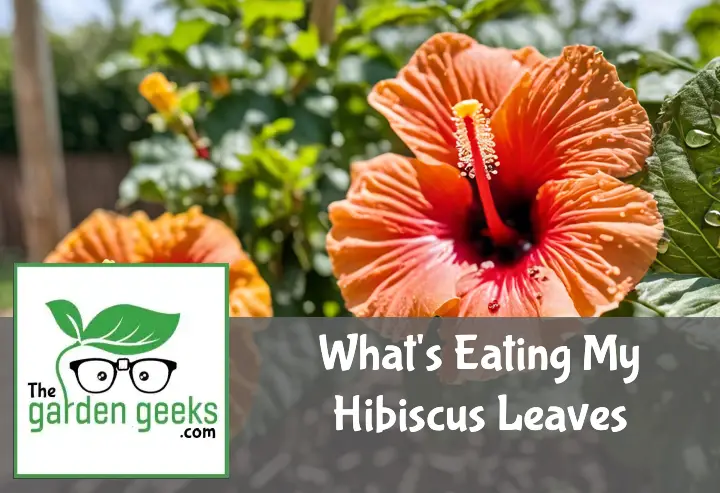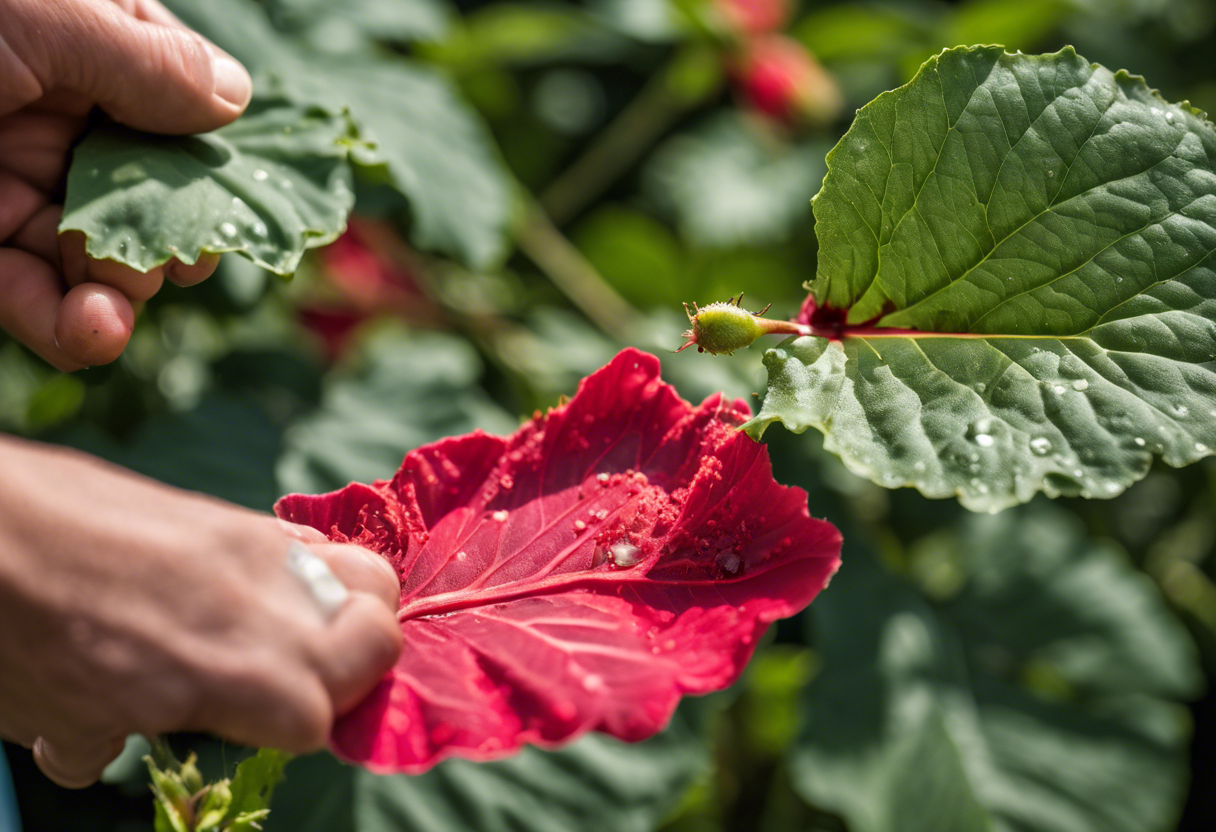Ever walked out to your garden, coffee in hand, only to find holes in the leaves of your favorite hibiscus plant? You might be wondering What’s Eating My Hibiscus Leaves? Well, my friend, you’re not alone. It’s a common query among hibiscus lovers.
Now, there could be a variety of culprits behind this leafy crime scene. From insects to diseases, many things can cause damage to these beautiful plants. But don’t worry! We’ll get into the nitty-gritty of identifying and solving this mystery together. Keep reading about What’s Eating My Hibiscus Leaves?
Key Takeaways
- The most common pests eating hibiscus leaves are aphids, whiteflies, and spider mites.
- Aphids are small, green insects that suck sap from the plant causing yellowing and curling of leaves.
- Whiteflies are tiny, white-winged insects that cause yellow spots and wilting.
- Spider mites are microscopic pests causing stippling or speckling on leaves.
- Each pest requires a specific treatment: insecticidal soap for aphids, neem oil for whiteflies, and miticides for spider mites. Regular inspection helps early detection and control.
What’s Eating My Hibiscus Leaves?
So, What’s Eating My Hibiscus Leaves? Well, it could be a number of things. Let’s dive into the world of hibiscus leaf problems, where pests and diseases are the usual suspects.
Common Pests That Attack Hibiscus
When we talk about hibiscus pests, a few notorious names pop up. First on our list are aphids. These tiny green or black insects love to feast on your hibiscus leaves, causing them to yellow and curl.
Next up, we have whiteflies. These little buggers can cause some serious damage to your hibiscus leaves by sucking out their sap. And don’t even get me started on mealybugs! They’re like the uninvited guests who never leave, causing your leaves to wilt and discolor.
Then there are spider mites, these microscopic villains can cause your hibiscus leaves to develop yellow spots and eventually drop off. Lastly, thrips might be small in size but they sure do pack a punch when it comes to damaging hibiscus leaves.
Identifying the Culprit: Signs and Symptoms
Now that we know who our potential culprits are, let’s learn how to spot them. Signs of aphids on hibiscus include curled or yellowed leaves with a sticky residue underneath.
If you notice tiny white insects fluttering around your plant or see a sooty mold on the leaves, you might have an infestation of whiteflies. For mealybugs, look for cottony masses on the undersides of leaves or at leaf joints.
Spider mites leave behind telltale signs like yellow spots or stippling on leaf surfaces. And if you see silver streaks or distorted growth on your hibiscus leaves, then thrips might be your problem. Remember, early detection is key when it comes to caring for hibiscus and managing these pests.
How Do These Pests Damage Hibiscus Leaves?
Well, pest damage on hibiscus is a real bummer. It’s like having uninvited guests at your party who eat all the snacks and leave a mess behind. These pesky critters, or as we call them, insects eating hibiscus leaves, munch away happily, leaving your beloved plant looking like Swiss cheese. And let’s not forget about the effects of pests on plants – it’s not just about aesthetics here.
Feeding Habits of Common Pests
Now, these common plant pests have some pretty gnarly feeding habits. They’re not just nibbling away at the edges – oh no! They go for the jugular, or in this case, the juicy middle part of the leaf. This behavior is what we call insect feeding habits.
And you know what? It doesn’t stop there. Some bugs have a special liking for hibiscus leaves and they don’t mind showing it. Their feeding patterns can be quite aggressive and this leads to significant pest damage to plants.
Impact on Plant Health and Growth
So, how does this affect our green friend? Well, imagine trying to do your thing with holes in your lungs – not fun! The same goes for our hibiscus buddy here. The damage caused by these insects has serious effects on plant health.
The constant munching disrupts photosynthesis (the plant’s food-making process), leading to stunted growth and poor health overall. This is what we mean when we talk about the impact of insects on plant growth.
And if that wasn’t enough, a severe infestation can lead to more serious plant health issues due to pests, like disease transmission or even death! So yeah, it’s safe to say that our hibiscus doesn’t appreciate these uninvited guests. It’s like a never-ending cycle of stunted growth from insect damage. So, the question remains – What’s Eating My Hibiscus Leaves? Well, stay tuned to find out!
How to Prevent Pests from Attacking Your Hibiscus?
When it comes to pest prevention in hibiscus, a stitch in time saves nine, folks! It’s all about creating an environment that’s not very inviting for those pesky critters. Let’s dive into how you can keep your hibiscus healthy and pest-free.
Choosing the Right Location for Planting
Believe it or not, where you plant your hibiscus matters big time. The right hibiscus planting location with ample sunlight and good soil can help deter pests. Also, remember to give each plant enough space to breathe. Too close, and you’re inviting a bug party!
Regular Inspection and Maintenance
Now here’s the thing: Inspecting hibiscus for pests regularly is like having a security guard for your plants. Coupled with proper maintenance practices like pruning and cleaning around the plant, you’re setting up a strong defense against What’s Eating My Hibiscus Leaves.
Natural Pest Deterrents
Last but not least, let’s talk about organic pest control for hibiscus. Homemade sprays or beneficial insects can be effective deterrents without harming Mother Nature. So next time you spot a ladybug on your hibiscus, say thanks instead of shooing it away!
How to Treat Infested Hibiscus Plants?
When it comes to treating infested hibiscus, you’ve got two main options: organic and chemical pest control for hibiscus. Both methods have their pros and cons, so let’s dive in and see what each one entails.
Organic Pest Control Methods
Organic pest control is all about using natural means to keep those pesky bugs at bay. It’s an eco-friendly pest solution that doesn’t involve any harsh chemicals. Instead, it uses organic insecticides for hibiscus that are derived from plants or minerals.
These treatments work by disrupting the pests’ life cycle or repelling them with smells they don’t like. The best part? They’re safe for your plants, pets, and the environment!
One popular technique involves introducing beneficial insects into your garden. These good guys eat the bad guys, helping to keep your hibiscus healthy. Another method is to use plant-based sprays that deter pests but are harmless to other creatures.
Chemical Pest Control Methods
On the flip side, we have chemical pest control. This method uses synthetic pesticides designed specifically for dealing with hibiscus pests. These chemical solutions for plant infestation can be highly effective at eliminating bugs quickly.
Chemical treatments work by killing pests on contact or disrupting their growth and reproduction. While these methods can be very effective, they should be used with caution as they can also harm beneficial insects and may pose risks to pets or humans if not used properly.
Remember folks, whether you choose organic or chemical methods, the key is consistency in application and monitoring your plants closely. After all, knowing what’s eating my hibiscus leaves is half the battle won!
To Wrap Up
In this leafy saga of What’s Eating My Hibiscus Leaves, we’ve discovered that the culprits are often insects or diseases. They’re like uninvited guests at a garden party, causing all sorts of havoc.
So, keep your eyes peeled and your green thumbs ready! With the right knowledge and care, you can protect your hibiscus from these pesky invaders.



